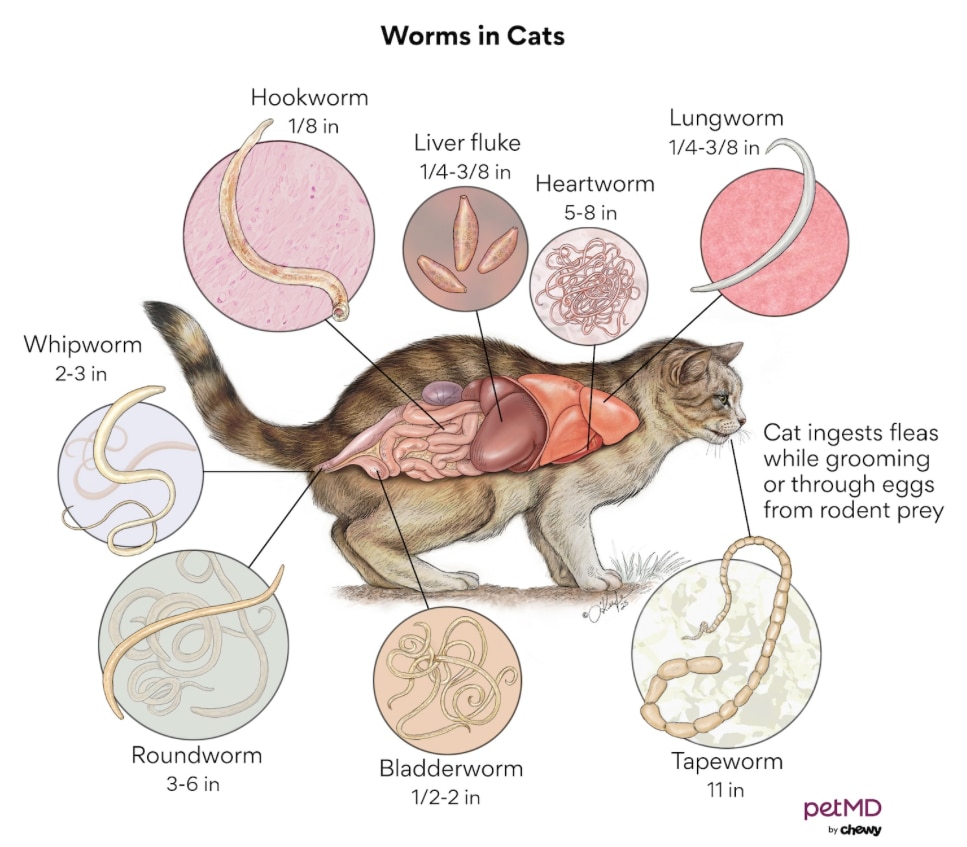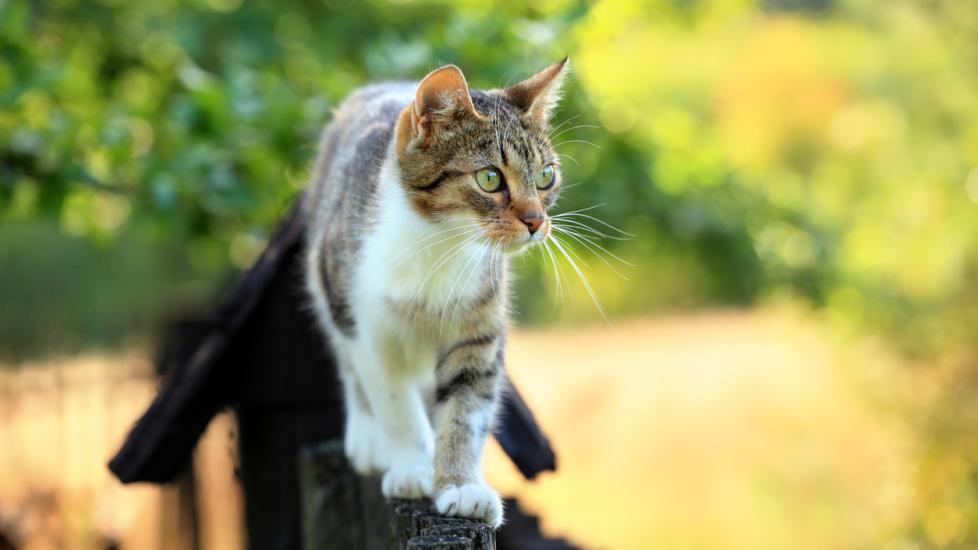Heartworm Disease in Cats: Symptoms, Treatment, and Prevention
iStock/konradlew
What Is Heartworm Disease in Cats?
Heartworm disease is caused by a parasite, Dirofilaria immitis, which is spread by mosquitos.
While cats are susceptible to heartworms, they are a fairly resistant, imperfect host—meaning they aren’t ideal for mosquitoes to feed on them. Cats acquire heartworm far less than dogs in the same geographic location, with only 5–20% affected.
Only around 25% of heartworms reach adulthood in cats. Typically, cats also have a low worm burden (usually one to four worms compared to hundreds in dogs), and less than 20% of those worms will produce microfilaria, the infective form of heartworm.
Cats also have higher rates of aberrant heartworm migration, which is when heartworms fail to migrate to the pulmonary arteries and instead travel to other body cavities, blood vessels, or the central nervous system.

Click here to download this medical illustration.
The life cycle of heartworms is complex and involves many larval, or immature phases:
-
First, a mosquito acquires microfilaria when it bites a dog infected with heartworm disease.
-
Once ingested by a mosquito, the microfilaria will molt, or transform, over the next 10–14 days into three different forms of larva: L1, L2, and L3.
-
After the third molt, the L3 larva can now infect new dogs and cats.
-
The mosquito bites a cat and transfers the infective L3 through saliva into the bite wound.
-
The L3 stays within the cat’s tissues for 3–4 days until it molts again to L4.
-
L4 remains in the tissues for approximately two months.
-
Finally, L4 molts to L5, the immature adult, which leaves the tissues via the bloodstream.
-
L5 lands in the pulmonary arteries—the vessels responsible for bringing oxygen-poor blood from the heart to the lungs to re-oxygenate.
-
L5 continues to develop in the pulmonary artery for another 4–6 months until, finally, it becomes an adult heartworm. The adult is capable, in some worms, of releasing microfilaria into the bloodstream to start the cycle all over again.
Stages of Heartworm Disease in Cats
The American Heartworm Society divides heartworm disease in cats into two stages:
-
Stage 1 occurs when immature L5 worms arrive in the pulmonary arteries, many of them dying. This causes a severe, acute inflammatory reaction (often misdiagnosed as asthma or other respiratory diseases) as the vessels and heart respond to the parasite.
-
Veterinarians and researchers call this acute inflammatory process heartworm-associated respiratory disease (HARD). As the living worms mature, the inflammatory response lessens, in part from the adult worms actively suppressing the immune system.
-
Stage 2 occurs when adult heartworms die, invoking a highly inflammatory, anaphylactic, and often fatal response. The dead worms start off a strong pulmonary inflammatory cascade, and a cat’s blood vessels are small and narrow.
-
When an adult heartworm dies, it easily causes an embolism. A cat who survives adult heartworm death will have permanent lung damage and chronic respiratory disease.
For PetMD's complete guide on heartworm disease in cats, click here.
For the Spanish version, click here.
Health Tools
Not sure whether to see a vet?
Symptoms of Heartworm Disease in Cats
Clinical signs of heartworm disease vary greatly in severity.
Some cats may not have any clinical signs at all. Most of the noticeable issues come from the adult heartworm suddenly dying and causing acute issues within the cat or abnormal worm migration causing tissue damage. When cats do show signs of illness, veterinarians most commonly see the following:
-
Exercise intolerance
-
Difficulty breathing
-
Increased breathing
-
Open-mouth breathing
-
Neurologic abnormalities—difficulty walking, (ataxia), and possible seizures
-
Sudden death
Causes of Heartworm Disease in Cats
The parasite Dirofilaria immitis is the cause of heartworm disease. It is transmitted by mosquitos.

Click here to download this medical illustration.
Warm areas, especially in the southern United States, allow efficient mosquito reproduction and, therefore, southern states have a higher percentage of heartworm in cats. Outdoor cats are more susceptible, but even indoor cats can acquire heartworm if a mosquito ventures inside.
How Veterinarians Diagnose Heartworm Disease in Cats
Heartworm disease in cats is often difficult to diagnose, especially compared to dogs. This is due to a range of testing factors including:
-
Tests for microfilaria may give frequent false negatives, since cats rarely have circulating microfilaria.
-
Antibody blood tests can detect immature infections early, even two months after infection. However, a positive result does not confirm an adult infection, and it can even remain positive after cats clear the infection.
-
Antigen blood tests are the gold standard of diagnosing dogs with heartworm disease but can only test for the presence of female heartworms. Because cats can have very low and single-sex (i.e. all male) worm burdens, this method of testing will also miss some feline infections.
-
Chest radiographs (X-rays) may help in diagnosing cases of feline heartworm disease because enlargement of pulmonary arteries and changes to the lung tissue are suggestive of heartworm disease. Common features of heartworms can be seen on X-rays in about half of cases.
-
Echocardiography (ultrasound) of the heart is useful to visualize the actual live worms in the pulmonary artery and right side of the heart. It can also help determine if pulmonary pressures are abnormal while excluding or confirming cardiac disease.
Positive blood tests, enlarged arteries on radiographs, and changes in the heart increase the level of suspicion of a heartworm infection.
While no test is perfect, your vet will use physical exam findings in addition to multiple types of tests to determine the severity of heartworm disease in your cat.
Treatment of Heartworm Disease in Cats
Treating heartworm disease in cats is difficult.
Many common therapies—including the most common canine treatment, merbromin—are toxic to cats. Merbromin, otherwise known as Immiticide, is used to kill adult heartworms in dogs but its use in cats has been associated with serious side effects that occur from worm death. The American Heartworm Society, the leading expert for care of heartworm-infected pets, does not currently recommend using therapies that kill adult heartworms in cats.
Cats who currently do not show any clinical signs may have the option of being monitored over time for a spontaneous cure. A spontaneous cure happens when the cat’s immune system naturally clears the heartworm infection without causing any problems and without treatment.
When it comes to medications to treat heartworm disease in cats, your vet may recommend:
-
Ivermectin—a medication that can reduce worm loads when given over a long period of time (two years or more). Allergic shock or an inflammatory reaction are two side effects of this medication in cats. Ivermectin is a common ingredient in heartworm prevention medication.
-
Prednisolone—a steroid that can decrease a cat’s strong inflammatory response, this medication is prescribed for those that have clinical signs such as coughing or evidence of lung disease on an X-ray. It helps to diminish the breathing issues associated with heartworm positive cats.
-
Doxycycline—an antibiotic that helps to remove the bacteria that lives inside heartworms and increases inflammation in cats.
-
Other medications such as terbutaline, theophylline, or albuterol may also be recommended to help with respiratory distress.
Because of the difficulty with medical management of heartworm disease in cats, the preferred method of treatment is to remove heartworms through surgery.
An invasive surgery can remove worms after entering the chest cavity and using forceps to directly remove the worms through the heart. However, all forms of surgery for heartworm in cats can lead to circulatory collapse and sadly death. That’s why prevention is key to helping your cat stay safe and protected from heartworms in the first place.
Recovery and Management of Heartworm Disease in Cats
All heartworm-positive cats should have serologic testing, echocardiograms, and chest radiographs performed every six to 12 months to monitor their heartworm status, whether they were treated or were asymptomatic. Ideally, veterinarians will perform both antibody and antigen tests to gather the most information.
Veterinarians will cautiously declare a cat “recovered” from heartworm disease once blood tests are negative in addition to resolution of clinical and radiological signs.
Without medication therapy or surgery, there is no cure for heartworm disease in cats. The goal is to keep the cat symptom free for as long as possible hoping that the cat outlives the worms. The median survival time for cats with heartworm disease is an average of one and a half to four years.
Managing heartworm-positive cats for success involves close monitoring, in-depth discussions with veterinarians, and full understanding of the risks of heartworm in cats.
Prevention of Heartworm Disease in Cats
Heartworm is a scary but preventable disease. Fortunately, there are plenty of heartworm medications for cats available on the market. In addition to preventing heartworm, many of these preventative medications also help to prevent intestinal worms, fleas, and tick activity.
Kittens can start preventatives around 8 weeks of age and continue their entire lives. A common misconception is that indoor cats don’t need heartworm prevention because they are indoors but think how often you are bitten in your own house. Mosquitoes can still make their way inside and find your cat just as easily.
Some common heartworm medications you can discuss with your vet include:
Heartworm Disease in Cats FAQs
How long can a cat live with heartworm disease?
The median survival time for cats at the time of diagnosis is four years.
What are the first signs of heartworm disease in cats?
Some cats are asymptomatic, but the most common first signs are lethargy, coughing, and vomiting.
Is heartworm disease in cats fatal?
Heartworm in cats can be fatal and unpredictable.
Is heartworm disease in cats contagious to other cats?
Heartworm is not transmissible from one cat to another without an intermediate vector, such as a mosquito.
References
1. Atkins CE. Feline Heartworm Disease: What’s New-2008. Western Veterinary Conference 2010.
2. González-Miguel J, Morchón R, et al. Identification of Dirofilaria immitis immunoreactive proteins recognized by sera from infected cats using two-dimensional electrophoresis and mass spectrometry. Mol Biochem Parasitol. 2010;174:78–82.
3. Atkins C. Heartworm Disease. Textbook of Veterinary Internal Medicine, 7th ed. St. Louis, Saunders Elsevier: 2010; 1353-80.
